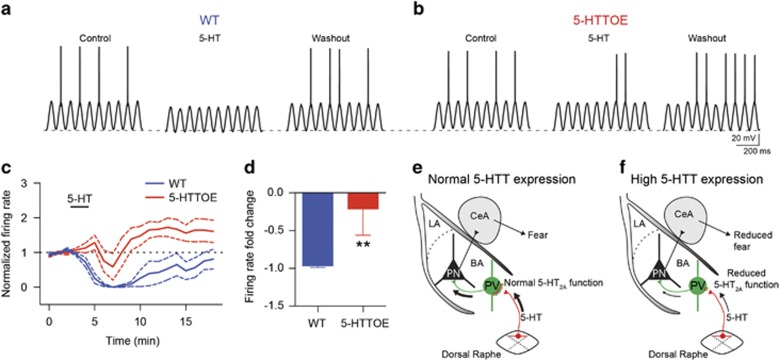Figure 5.
Increased 5-hydroxytryptamine transporter (5-HTT) expression alters the output of basal amygdala (BA) principal neurons (PNs). (a) Sinusoidal current (160 pA intensity) injected at theta frequency (6 Hz) in a representative wild-type (WT) PN current clamped at −60 mV. Application of 5-hydroxytryptamine (5-HT) (50 μM) causes hyperpolarization (2–3 mV) and suppression of firing. (b) Sinusoidal current injection (190 pA) at theta frequency (6 Hz) in a representative 5-HTT-overexpressing (5-HTTOE) PN recorded in the current clamp at −60 mV. Application of 5-HT produces a weaker hyperpolarization and fails to suppress firing. (c) Time course of the effect of 5-HT on the firing rate of WT and 5-HTTOE PNs (sinusoidal current injections shown in (a) and (b) delivered every 10 s). (d) 5-HT evokes a significantly stronger depression of firing rate in WT (n=6 from three animals) compared with 5-HTTOE (n=5 from two animals) PNs. (e and f) Model of amygdala circuit alterations in 5-HTTOE mice. (e) Dorsal raphe firing, leading to the release of 5-HT in the BA, excites parvalbumin-expressing interneurons (PVINs) through 5-HT2A receptors, leading to indirect perisomatic inhibition of PNs. (f) Increased 5-HTT expression, characterized by lower 5-HT tone because of more efficient 5-HT reuptake, causes reduced 5-HT2A receptor function on PVINs, leading to a failure of dorsal raphe activity to recruit PVINs. This could affect the encoding of sensory stimuli (conditioned stimulus (CS) and unconditioned stimulus (US)) by the PNs, dampening fear responses. **P<0.01. The color reproduction of this figure is available on the Neuropsychopharmacology journal online.

